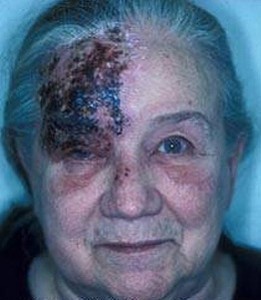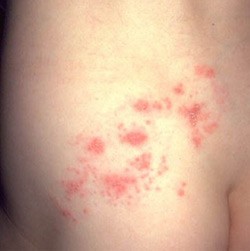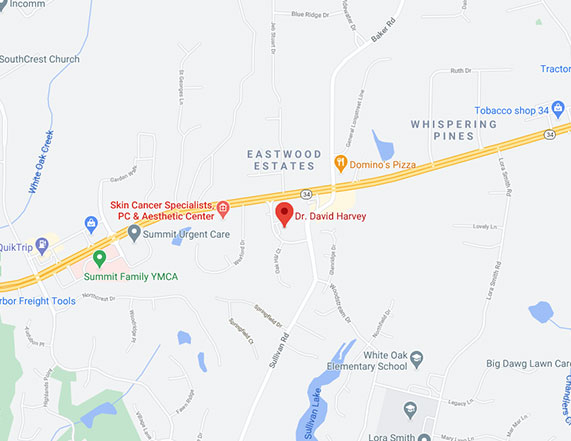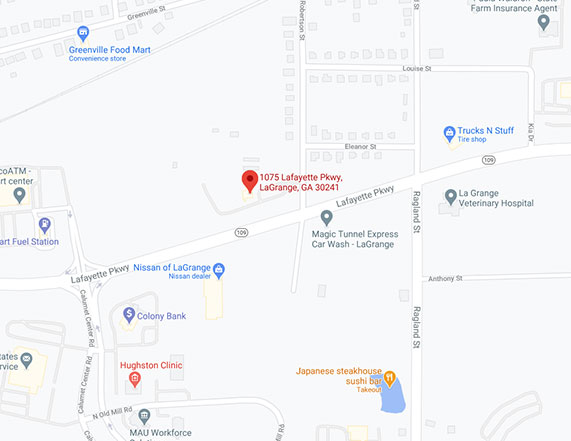Conveniently located to serve Newnan, Peachtree City and LaGrange
Click here to jump to:
Newnan Shingles
WHAT ARE SHINGLES?
Shingles or Herpes Zoster is a skin condition characterized by a painful itching rash which can occur over multiple body areas. Anyone who has had a previous history of chickenpox or the immunization against the chickenpox virus can develop this disorder. Both the chickenpox virus (varicella) and the shingles virus are related. It is thought that the initial chicken pox virus remains in a dormant state for many years. With the appropriate stimulation, i.e. stress, infection, heat, cold or time, the chicken pox virus can reactivate and cause a shingles rash to occur.

Swelling and early blistering around forehead and left eye – a medical emergency.
WHO IS AFFECTED BY SHINGLES?
All sexes and races are equally susceptible to shingles. The disorder occurs more commonly in those over the age of 50. It is estimated that over 20% of the total population can expect to suffer from shingles during their lifetime. Prior to the AIDS epidemic, approximately 300,000 to 400,000 cases of shingles occurred annually in the United States. Those who have a suppressed immune system or suffer from diabetes, cancer or HIV infection have a higher rate of shingles development. Some studies suggest that shingles can be a marker for certain types of cancer, however, this is still under investigation and no definitive conclusions have been made as to whether this hypothesis is true.
WHAT ARE THE SYMPTOMS OF SHINGLES?

Shingles-occurring in a dermatome or an area of the skin characterized by a nerve group.
The main symptoms are burning and itching. This often occurs in a localized region of the skin that is defined by a nerve grouping. Discomfort usually begins one to two days before the shingles rash develops. Fever, chills, cough or headache may accompany initial symptoms. When the rash is fully developed, it is characterized by a “clustered” group of blister. Blisters occur over a “dermatome” or segment of the skin that is defined by a localized group of nerve fibers. They can last up to two to three weeks depending on the immune status of the affected individual. Pus can also be noted in the blisters, however, this is only temporary because the blisters usually crust over and disappear by seven to ten days.
Related
Content
Patient
Review
“Dr. Harvey and his staff are awesome–friendly, professional and efficient.”
by CS
HOW INTENSE IS THE PAIN FROM A SHINGLES INFECTION?
Pain can be mild or severe. It can lasts from months to years after a shingles flare. This is referred to as post herpetic neuralgia. Dr. Harvey can employ various pain control measures to alleviate a patient’s discomfort. In extreme cases, nerve blocks or surgery may be indicated.
WHERE DOES A SHINGLES ERUPTION USUALLY OCCUR?
The trunk and chest is the most frequently affected area followed by the lower back, face, neck and buttocks. Widespread shingles can also occur and is considered a life threatening emergency. This can be seen in infants or those with a very suppressed immune capacity. When shingles affects the nose or the cheek, one must be concerned about the potential for eye involvement. This is because those nerves which innervate the face and nose can also send signals to the eye. Dr. Harvey may recommend that an ophthalmologist be consulted if a group of small, clustered blisters appears on your nose or forehead.
WHAT OTHER COMPLICATIONS CAN ARISE AS A RESULT OF SHINGLES?
Besides the risk of pain and visual loss, shingles can result in a secondary bacterial infection of the skin. In these instances, antibiotics and skin cultures may be necessary.
HOW IS THE DIAGNOSIS OF SHINGLES MADE?

“Balloon like cells” seen from a microscopic evaluation of blister fluid.
A complete skin exam is the most common way to make the diagnosis of shingles. Sometimes blister fluid may be cultured or sampled for its cellular makeup. Affected cells tend to form clumps in a balloon pattern. If there still a doubt as to the diagnosis, we can biopsy the rash to determine the exact etiology.
IS SHINGLES CONTAGIOUS?
Yes, but less so than the initial chicken pox infection. Newborns and those patients with a suppressed immune system are at high risk. Contact with the blister fluid is necessary for viral spread so it is important to be careful not to touch a blister that has fluid in it.
CAN SCARRING OCCUR WITH SHINGLES?
Yes, scarring can occur in patients who have a widespread disease or whose treatment is resistant to antiviral medications. Thankfully, scarring is not a common occurrence when a shingles eruption occurs.
WHAT ARE SOME OF THE TREATMENTS AVAILABLE FOR SHINGLES?
Antiviral agents such as acyclovir, Valtrex™ or Famvir™ are first line medications for the treatment of shingles. These medications work through inhibiting viral replication. Dr. Harvey may also recommend topical treatments such as Denavir™ cream, oatmeal baths or corticosteroid creams to help with symptoms of itching or burning. Finally, for those cases in which intense pain develops, anesthetic creams or nerve blocks may be employed. A vaccination (Zostavax) is also available. It is important to remember to:
- Avoid picking or scratching at fresh blisters as this can increase the risk of spreading a shingles infection.
- Do not take aspirin if you have shingles as flu like symptoms may occur.
- An eye exam is required for a shingles rash that occurs on the cheek or nose.
- If you suffer from repeated bouts of shingles, a thorough physical examination is required.
- For uncontrolled pain, a neurology or pain management consultation may be needed.
If you are concerned about shingles, click here to set up an appointment or call us. We look forward to helping you.











